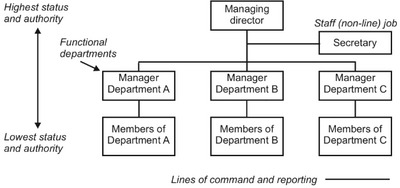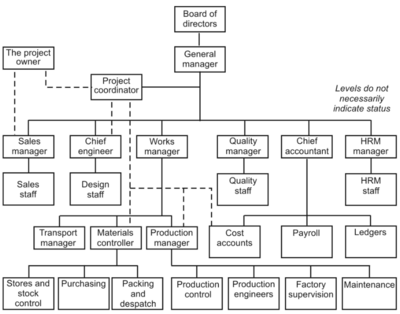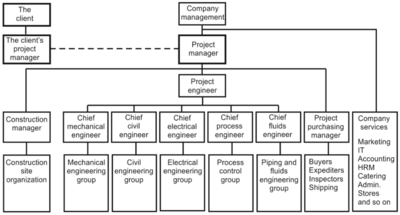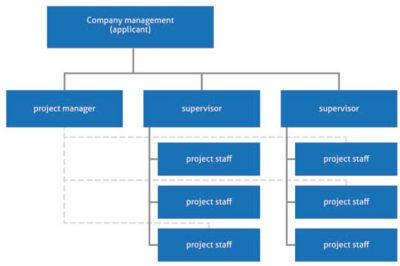Project organization
Marcus chr (Talk | contribs) |
Marcus chr (Talk | contribs) |
||
| Line 123: | Line 123: | ||
Despite that today's project management is heavily dominated by an agile approach, the traditional practice of project organization is still essential to achieve the desired objectives of a project. The informal approach of agile project management built on a dynamic and fluid approach experience difficulties without any implementation of traditional project management practices <ref name="kerzner"/>. Hence, even in an agile project management environment, establishing an efficient project organization creates a structured project management foundation. Consequently, the uncertainty related to responsibility and accountability is minimized as much as possible. Implementing this traditional project management practice will complement the agile approach by ensuring everyone knows their assigned responsibility. This makes more room for the project team to navigate smoothly in the agile project management environment and focus on the right things. | Despite that today's project management is heavily dominated by an agile approach, the traditional practice of project organization is still essential to achieve the desired objectives of a project. The informal approach of agile project management built on a dynamic and fluid approach experience difficulties without any implementation of traditional project management practices <ref name="kerzner"/>. Hence, even in an agile project management environment, establishing an efficient project organization creates a structured project management foundation. Consequently, the uncertainty related to responsibility and accountability is minimized as much as possible. Implementing this traditional project management practice will complement the agile approach by ensuring everyone knows their assigned responsibility. This makes more room for the project team to navigate smoothly in the agile project management environment and focus on the right things. | ||
| − | |||
| − | |||
| − | |||
== References == | == References == | ||
| Line 143: | Line 140: | ||
</references> | </references> | ||
| + | |||
| + | == Annotated bibliography == | ||
Revision as of 14:04, 30 April 2023
Purpose --> Understanding the context
Abstract
The success of a project is highly dependent on the term project organization. The term is defined as a clear establishment of the project management team structure along with a communication approach in the beginning of the project. Maintaining the project organization during the entire project is essential to make the project a success. According to the PRINCE2 standard, the purpose of project organization is to define and establish the project's structure of accountability and responsibilities [1].
To successfully create and institutionalize a project organization, the project authority should be clearly communicated throughout the project team. This implies that each project team member knows their respective responsibilities. An effective way to visualize and hence intuitively communicate the organizational structure along with its division of authority is using organization charts (or organigrams). [2].
Contents |
Big idea
Project organization is a term describing the structure of a project throughout its entire lifecycle based on communication, coordination and management. The purpose of project organization is to define a structure of responsibilities and accountability across the project management team [1]. Therefore, an effective establishment of a project organization requires unambiguously communicated authority. Additionally, each project management team member should know their specific role along with the associated responsibilities. This decrease of confusion and uncertainty about responsibility and accountability will reduce the risk of conflict emergence between employees working on the project. Also, a well-defined project organization establishes common expectations among the project team members, which implies a united project team work to achieve the desired project objectives. Neglecting efficient organization of projects often leads to a lack of motivation, which causes schedule overruns and hence budget overruns [2]. Accordingly, well planned project organization and maintaning it during the project is essential to the success of the project [3].
State of the art
The modern way to establish an effective organizational is to create an organization chart. Organization charts vertically represent the role or status and authority of each organization member. The status and authority decreases from top to bottom of the chart, which means the most powerful member organizational role is located in the top of the chart. An example of organization chart is given in Figure 1. This tool is very powerful to demonstrate and clearly communicate the authority and roles within projects. Additionally, it emphasizes the internal organizational context of the project. This can further be useful to communicate the organizational project governance structure and interdependencies between the specific project and other projects and/or programs of the organization [2].

Application
To ensure success of the project as a project manager, efficiently establishing a project organization is essential. However, since project managers tend to work in large organizations with many employees, it is redundant to create an organization chart involving the whole organization with all its associated nuances and politics. Therefore, it is recommended that project managers focuses only on the people having influence on activities of the project while creating the project organization structure.
Before initiating the creation of an organization chart, several different aspects are important to consider.
First of all, it is significant to consider what roles that needs to be assigned within the project team to achieve the defined objectives. The term role refers to a specific function assigned to an individual.
Since the project team roles identifies the functions needed to make the project a success, it is important to determine which competences that are associated with each role. When the identification of desired competences is executed, the roles are assigned to individuals from the organization. However, sometimes it is required to hire people to acquire the optimal competences if these are not already obtainable within the organization.
Assigning the roles to the right people implies assigning the responsibility associated with the roles. The individuals fulfilling their roles are accountable of the completion of the project activities related to their role of the project.
The authority over the project might already be determined and distributed between the project manager and their managers [4]. In traditional project management, this would often be the case where mostly the project manager made the important decisions, managed deliverables and applied resources. However, today's project management is highly influenced by an agile approach. In this environment, the management style is rather participative than authoritarian. This implies that the management of the project team members is built on trust, which means that decisions made regarding the completion of project activities are made progressively by the project team members themselves [3]. Hence the authority over the project is more divided between the project team members in the agile project environments.
Creating an organization chart
Ultimately, the organization chart of the project will be associated with the overall structure of the company regarding division of authority and roles. Therefore, if the organization in which the project takes place already has an organization chart, it is advantageous to either draw inspiration from that or create the organization chart of the project directly on the one made by the company.
Assuming the required roles within the project team are fulfilled, each role is supposed to be indicated as a box containing the function and the name of the employee. By convention, the function of an employee is supposed to be the job title. The boxes are then arranged with regard to authority, where the most powerful role of the project is placed at the top. As illustrated in Figure 1, the manager of Department A is above the members of Department A. If this department e.g. represented a project team, the project manager would be the manager of Department A, while the project team would be represented as boxes below the project manager. Usually in case of smaller projects, the project team members are represented with equal authority, i.e. they are placed side-by-side horizontally. However, large projects often tend to deviate from this flat structure due to the increasing amount of employees. Accordingly, the authority is distributed further within the project team, and this implies more layers of authority below the project manager. The solid lines illustrated in Figure 1 demonstrates lines of command. Downwards, the lines indicate who the employee can give commands to. Upwards, the lines indicate who the employee has to report to. Dotted lines between employees demonstrate appointed lines of communication or reporting. E.g. in Figure 1, the manager of department B might have to communicate with the members of Department C for some specific reason, and this would then be indicated by a dotted line. However, the dotted lines are not usually implemented in organization charts. Finally, staff roles such as the Secretary in Figure 1 have no direct authority. Nevertheless, by supporting their line manager, they exploit the authority and status of their manager.
There exist a broad range of different types of organization charts based on the terms and definitions specified above. The most efficient ones regarding project organization are staff line project organizations, and project team organizations and matrix organizations. Regardless of how the project is organized within the organization, the project manager has the complete responsibility of achieving the desired goals and objectives of the project [2] [5].

Staff Line Project organizations
A staff Line Project organization [5] is an organizational structure often referred to as a coordination matrix or a functional matrix. This kind of organization chart is used when a project is executed within an organization alongside its regular manufacturing activities. Consequently, the original line of command of the organization and its authority is allowed to continue normally parallel to the project execution. However, this implies that the project manager has no authority over any manager or their staff, and thus the project manager does not have a fixed project team. Accordingly, the project manager must have high skills in dealing with people along with associated skills in motivation and reasoning. An example of a staff Line Project organization is illustrated in Figure 2. Note that the project manager in this figure is called Project coordinator, and the vertical levels generally but not necessarily indicate authority.
In case conflicts arise and the project manager fails to resolve the matter, the project manager has the opportunity to seek support from the senior management. Hence the project manager can obtain the power needed to accomplish the needed changes to achieve the desired project objectives. This use of the management's authority is equivalent to how the secretary in Figure 1 acquires authority in certain situations [2].
The advantages of using a staff Line Project organization are:
- "The organizational structure will not be changed
- The project organization can be set up and dissolved again quickly
- Project staff remain in their departments and can draw their expertise from there" [5]
The disadvantages of using a staff Line Project organization are:
- "The project manager has no direct right to issue instructions
- Coordination is very time-consuming
- Measures are often difficult to enforce" [5]
Staff Line Project organizations are most applicable in either non-critical and smaller projects or strategic and cross-departmental projects [5].

Project team organization
In case a project has its individual autonomous unit within an organization, the organization chart of the project is defined as a project team organization (also called pure project organizations or autonomous project organization). The role of the project manager of this project organization is completely opposite to their role in project team organizations. In project team organization charts, the project manager is located on top of the autonomous project unit. This implies the project manager has a direct line of authority over all project employees. Hence the project manager is accountable for all specialized project facets alongside the traditional activities of work allocation, planning and progress. Such an organizational chart is shown in Figure 3, which illustrates an example of a project team established to construct and design a chemical processing plant. The example demonstrates a project as an individual and autonomous unit within the organization due to its organized departments, which respectively are accountable for their own industrial disciplines required to achieve the desired project objectives. Since the project manager has complete responsibility over all project aspects, communication between technical practices are easier, and motivation of employees across departments becomes easier to achieve for the project manager. One way to enhance efficient communication within the project team across areas of expertise is by using the approach of war rooms [2].
The advantages of using a project team organization are:
- "High identification of the project staff with the project
- Clear structures and both technical and disciplinary right of instruction by the project manager
- Direct communication" [5]
The disadvantages of using a project team organization are:
- "High effort for reintegration of project staff into the line organization
- Knowledge exchange with specialist departments difficult" [5]
Project team organizations are most applicable in either time-critical, large or international projects [5].

Matrix organizations
A matrix organization is the most applied project organization and is structured as a combination of both the staff line project organization and project team organization. An example of a matrix organization is shown in Figure 4, which indicates that the project manager does not have completely direct authority over the project staff that are specialists of their respective departments. However, the project manager partially has authority over the project employees, since they are available to the project in different fractions of their time. Due to this constellation of their working hours, they report both to their department manager and the project manager. This can cause conflicts regarding whether to prioritize tasks for the project or the department, which implies communication is crucial to succeed in this project organization.
The advantages of using a matrix organization are:
- "Employees remain in their departments, so that reintegration after the end of the project is not necessary.
- Employees can benefit from the knowledge and exchange in their specialist department
- Flexible access to resources" [5]
The disadvantages of using a matrix organization are:
- "Conflicts between project and department management possible (employees have two superiors)
- Problems with prioritization between line and project work" [5]
Matrix organizations are most applicable in either deadline-critical or medium to large projects [5].
Limitations
It is important to acknowledge that effective project organization only reduces the need for change throughout the project lifecycle and does not completely eliminate the need for change. Therefore, despite organizing the project effectively, project managers still need to be open-minded towards changes throughout the project lifecycle [3].
Organization charts
Despite organization charts are very effective to communicate organizational structure and division of authority, they are illustrated by vertical lines of communication. In practice, communication is far more complex due to informal communication across the organization. Hence this tool is mostly applicable to emphasize organizational structure and its responsibility division rather than constraining the organizational communication [2]. For instance using the Organization chart simplified example above, the manager of department A could be using the members of department B as consultants temporarily. In that case, the members of department B will report to the manager of department A instead of the manager of department B. Therefore, organization charts are effective foundation for project organization but not necessarily for strictly defining organizational communication.
Due to organizational changes or new projects arising, it is advantageous to create new organization charts. However, the resulting organizational changes of individuals' status or authority can cause unexpected reactions from people. Some people may feel they are not appreciated as sufficiently important employees, and an organizational feeling of injustice can arise [2]. A potential solution is to distribute updated organization charts with a thorough explanation and enable employees to express their feelings and thoughts through open communication.
The organization charts typically only show the role of the project team member and not the specific assigned responsibilities. To emphasize the assignment of project tasks to individuals or teams within the overall project team, a Responsibility assignment matrix is suitable to apply. An effective way of doing this is to construct and implement a RACI matrix, which describes different categories of responsibility assignment [4].
Find a source describing that project organization is bad
Staff line project organizations
- What can this tool/method do, and under what circumstances should it be applied?
- Is this tool/method a part of the current standards of project organization, or does it extend the current standards of project organization?
Project team organizations
- What can this tool/method do, and under what circumstances should it be applied?
- Is this tool/method a part of the current standards of project organization, or does it extend the current standards of project organization?
Matrix organizations
- What can this tool/method do, and under what circumstances should it be applied?
- Is this tool/method a part of the current standards of project organization, or does it extend the current standards of project organization?
Project organization in an agile project management environment
In the modern business society characterized by rapid project execution, it can be difficult to develop a comprehensive project organization due to the lack of available information in the beginning of projects. Because of this continuously increasing uncertainty, it is beneficial to manage projects in an agile environment.
Despite that today's project management is heavily dominated by an agile approach, the traditional practice of project organization is still essential to achieve the desired objectives of a project. The informal approach of agile project management built on a dynamic and fluid approach experience difficulties without any implementation of traditional project management practices [3]. Hence, even in an agile project management environment, establishing an efficient project organization creates a structured project management foundation. Consequently, the uncertainty related to responsibility and accountability is minimized as much as possible. Implementing this traditional project management practice will complement the agile approach by ensuring everyone knows their assigned responsibility. This makes more room for the project team to navigate smoothly in the agile project management environment and focus on the right things.
References
- ↑ 1.0 1.1 A. (2017). Managing successful projects with prince2 2017 edition. The Stationery Office Ltd.
- ↑ 2.00 2.01 2.02 2.03 2.04 2.05 2.06 2.07 2.08 2.09 2.10 D. Lock, Project Management. 10th edn., (Gower Published Limited, 2013), pp. 131–154.
- ↑ 3.0 3.1 3.2 3.3 Kerzner, Harold. (2017). Project Management: A systems approach to planning, scheduling, and controlling - Section 11.8 and 8.12. 12th ed. Wiley.
- ↑ 4.0 4.1 4.2 Gary L. Richardson and Brad M. Jackson. 2018. Project Management Theory and Practice - Section 17.1, Third Edition (3rd. ed.). Auerbach Publications, USA.
- ↑ 5.00 5.01 5.02 5.03 5.04 5.05 5.06 5.07 5.08 5.09 5.10 5.11 Witte, F. (2022). Project Organization. In: Strategy, Planning and Organization of Test Processes. Springer, Wiesbaden.
Cite error: <ref> tag with name "PMI" defined in <references> is not used in prior text.